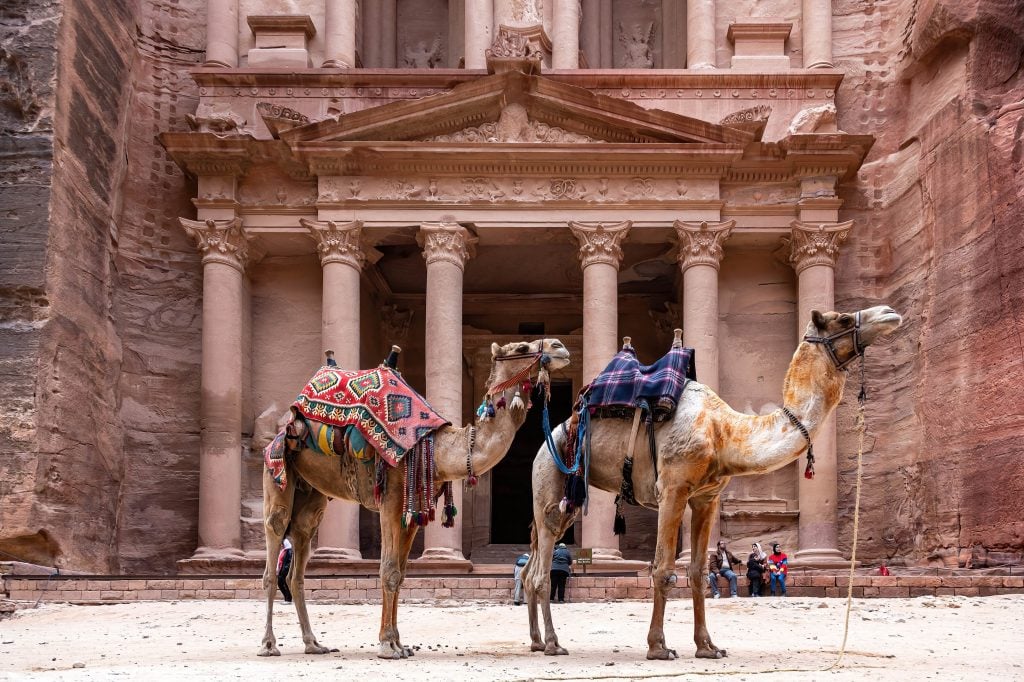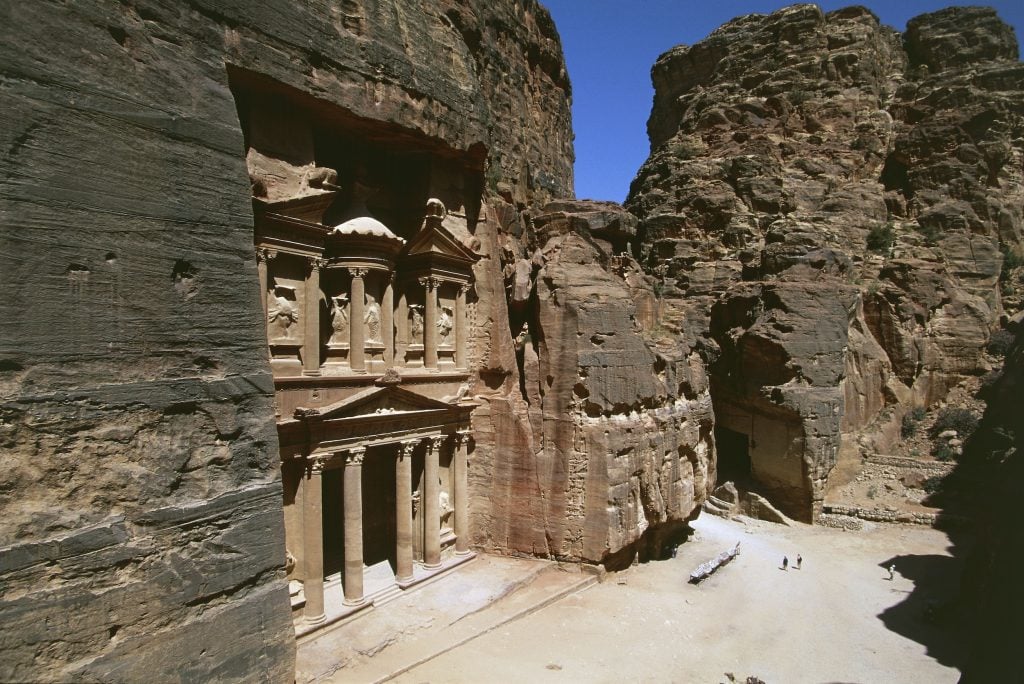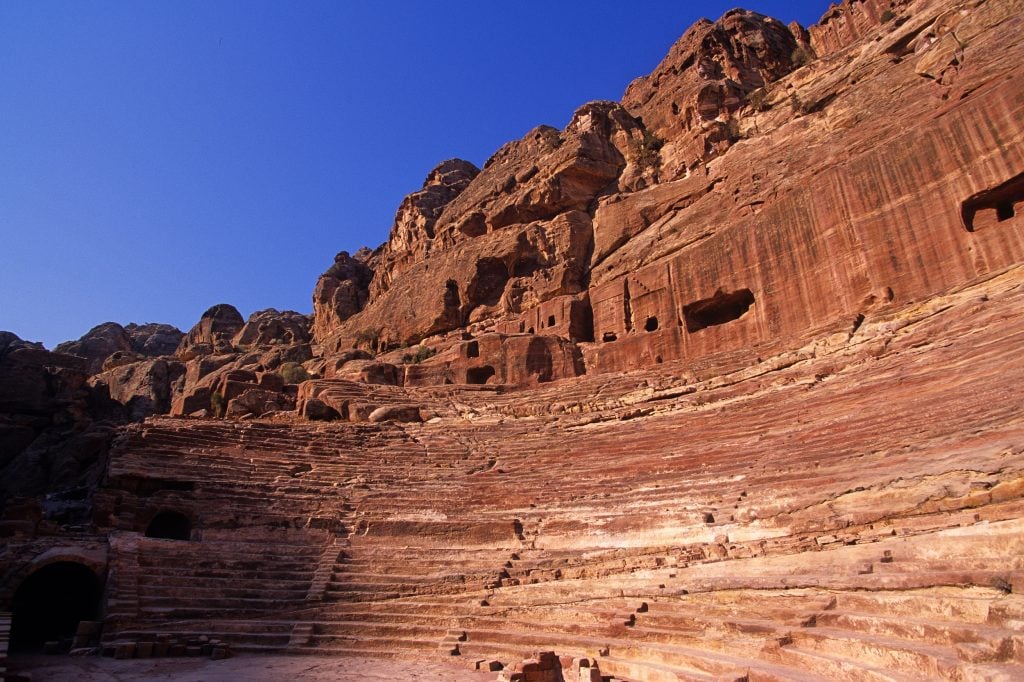Archaeology & History
Huge! The Massive and Mystical Jordanian Monument to an Enigmatic People
Petra also appeared in an "Indiana Jones" flick as the home of the Holy Grail.

Nestled amid the rugged desert canyons of southwestern Jordan, where traders and their caravans of camels once carried silk and frankincense, lies the ancient city of Petra. Known as the “Rose City” for the warm pink blush of the sandstone cliffs it is carved out of, Petra was built by the enigmatic Nabateans. Little is known about the nomadic merchant folk, an ancient Arab people who inhabited northern Arabia and the southern Levant.

View of the Treasury (Al-Khazneh), Petra (UNESCO World Heritage Site, 1985), Jordan. Nabataean civilization, 1st century C.E. Getty Images.
The Nabateans amassed incredible wealth through the trade of incense, spices, and fabrics, facilitating commerce between the Far, Middle, and Near East. Petra, their capital city, was the Nabateans’ crown jewel. Built over two millennia ago, it was long lost to the shifting sands of Jordan’s desert until it was rediscovered by European travelers in the early 1800s. It has been a UNESCO World Heritage Site since 1985, and this month celebrates its 17th year as one of the New Seven Wonders of the World, an honor it was awarded after 100 million votes were cast around the world.
The Nabateans’ enormous fortune and mirage-like existence, concealed in the high desert, protected them from foreign conquerors for centuries. In that time, caves were hewn and temples and tombs were built across the city’s 23 square miles, stretching across mountains, valleys, and riverbeds. Today, Petra is visited by almost 1 million travelers annually, who come to marvel at its architecture, which boasts monuments built at the scale of giants. (While the facade has appeared in many feature films, that number grew vastly after the site was featured in the 1989 movie Indiana Jones and the Last Crusade.)

Archaeological site of Petra, the Royal Tomb, in Jordan. Photo: Frédéric Soltan/Corbis via Getty Images.
The arrival of the Romans to Petra in 63 B.C.E. ushered in an era of massive expansion and mammoth construction projects. An amphitheater with seating for 8,500 spectators was carved out of solid rock. The Monastery, one of Petra’s legendary monoliths, stands at almost 150 feet high and 165 feet wide. It can be accessed by a 40 minute walk up 800 steps that were chiseled from the ground almost 2,000 years ago. The Treasury is arguably Petra’s signature architectural wonder, combining Hellenistic architectural elements with traditional Nabataean rock-cut temple designs.
The iconic structure looms at almost 130 feet tall, sculpted out of a sandstone rock face. It is most notable for the intricacy of its facade, in contrast with the relatively small, plain hall at its interior, formerly used as a royal tomb for deified kings. The Treasury’s facade is decorated with Corinthian columns and figures, emblematic of the blending of architectural styles that is Petra’s hallmark. Its lower level boasts guardian statues of the twins Castor and Pollux, who lived between Olympus and the Underworld. On the upper level, sculptures of dancing Amazons. The design was clearly influenced by Alexandria, the era’s most important Eastern Mediterranean city, and may have been constructed with the assistance of Alexandrian craftsmen.
According to local legend, the funerary urn crowning the facade holds a pharaoh’s treasure. The urn is peppered with bullet holes that the Jordanian government attributes to treasure-seeking Bedouins who tried to shoot the urn down and loot its contents.
The monument is speculated to have been built in the 1st century C.E., during the reign of King Aretas IV. Kings who followed wielded their treasuries to build even greater structures in order to compel history to remember them as even greater titans than their predecessors. Alas, these megastructures were lost to the sands of time, damaged or toppled by a series of earthquakes that wrecked Petra around 600 C.E., leading to the city’s abandonment.
Sometimes, archaeology gets big. In Huge! we delve deep into the world’s largest, towering, most epic monuments. Who built them? How did they get there? Why so big?





